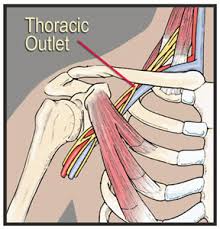
Thoracic outlet syndrome is a constellation of signs and symptoms caused by compression of nerves, arteries and veins as they exit the neck into the shoulder and arm. Symptoms include neck, shoulder and arm pain, numbness and tingling and discoloration, depending on which structures are compressed. The passageway for the nerves, arteries and veins can be compressed by any one of a number of causes. Abnormalities of the bones or ribs can cause compression. Enlargement of the muscles, weight gain, trauma and tumors are other causes of compression. Thoracic outlet syndrome usually occurs in women between 25 and 50. Problems that can mimic thoracic outlet syndrome include cervical disc disease, abnormalities of the spinal chord and brachial plexopathy from such things as Pancoast tumor. The symptoms of thoracic outlet syndrome are worsened by holding the arm over the head. Adson test is used to diagnose thoracic outlet syndrome. The pulse is palpated at the wrist. Then the head is extended and turned toward the side of the symptoms. If the pulse is diminished then that is suggestive of thoracic outlet syndrome.
There are several tests that are used to diagnose thoracic outlet syndrome. X-rays are useful to look for bony abnormalities that may cause compression of structures. MRI scan can be used to look for tumors or problems in the cervical spine. An EMG and nerve conduction study is an electrical test to look for the site of nerve damage. An angiogram is a special X-ray using dye that looks for compressed blood vessels.
Treatment of thoracic outlet syndrome begins with conservative modalities such as alteration in activities, heat, ice, physical therapy and medications. The types of medications which are useful include non-steroidal anti-inflammatories, Gabapentin, Carbamazepine and Baclofen. Rarely, surgical measures are used to take pressure off the nerves and vessels.